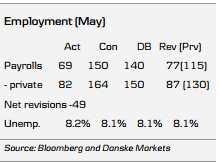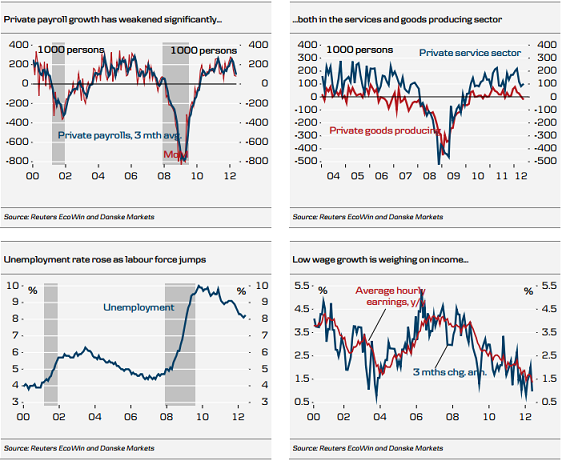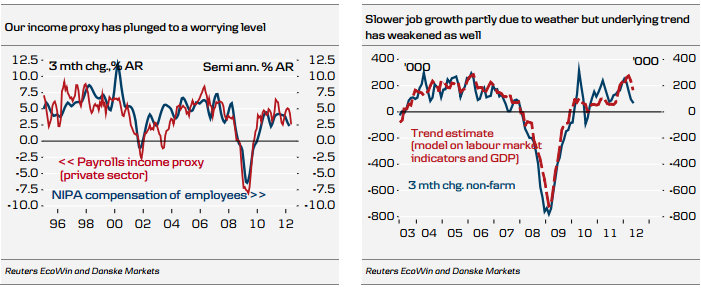- The May employment report was overall disappointing with weakness in job growth across a broad range of sectors. While some of the current weakness can be explained by a payback from the warm winter months, the underlying state of the labour market seems to be weakening as well.
- The implications of today’s report are twofold. First, it is clear that private consumption growth cannot keep up momentum if the labour market does not recover.
- Second, we expect the Fed to err on the side of caution and implement QE3 at the 20 June FOMC meeting to facilitate stronger growth. We expect Ben Bernanke to indicate this at his testimony before Congress on Thursday 7 June.

Details
Over the past three months, job growth has slowed from an average of 252,000 per month in December to February to 96,000 from February to May. Some of the slowdown can be explained by warm winter weather as the unusually warm weather has likely pushed forward some of the seasonal boost to hiring, which usually occurs in the spring months. This is now showing up as weakness in the weather-dependent sectors such as construction and leisure and hospitality. However, this is unlikely to explain all of the loss in job growth.
Turning to the details, weakness in the establishment survey was evident also outside of the most weather-dependent sectors. Private payrolls rose a modest 82,000, the government shed 13,000 and net revisions to April and March amounted to -49,000. Construction employment was a big negative shedding 28,000 persons, which points to some payback from warm winter months. The same goes for leisure and hospitality, which shed 9,000 persons after adding on average 37,000 per month in the three months
from December to February. Weakness was also seen in other places though, with manufacturing adding only 12,000, retail trade 2,000 and temporary help services grew a modest 9,000. The best performing sector was transportation adding 54,000 jobs and education and health with 46,000.
The average private workweek held steady at 33.7 but aggregate hours dropped 0.2%. With hourly earnings rising only 0.1%, our proxy for nominal income growth plunged to 2.7% annualised, which is clearly not enough to hold up private consumption growth at the current levels.
One positive was that the household survey showed an increase of 422,000 in employment but with 642,000 joining the labour force, unemployment rose one notch.
Assessment and outlook
With at least some of the current weakness related to weather distortions, we expect job growth to rebound in coming months. That said, economic data has been mixed lately, with the most recent prints on initial jobless claims, consumer confidence and pending home sales signalling a slowdown in growth.
We expect the Fed to react to the weakness in the labour market and believe the chance of another round of quantitative easing at the 20 June meeting has risen to 80% following today’s employment report.

Disclosure
This research report has been prepared by Danske Research, a division of Danske Bank A/S ("Danske Bank").
Analyst certification
Each research analyst responsible for the content of this research report certifies that the views expressed in the research report accurately reflect the research an alyst’s personal view about the financial instruments and issuers covered by the research report. Each responsible research analyst further certifies that no part of the compensation of the research analyst was, is or will be, directly or indirectly, related to the specific recommendations expressed in the research report.
Regulation
Danske Bank is authorized and subject to regulation b y the Danish Financial Supervisory Authority and is subject to the rules and regulation of the relevant regulators in all other jurisdictions where it conducts business. Danske Bank is subject to limited regulation by the Financial Services Authority (UK). Details on the extent of the regulation by the Financial Services Authority are available from Danske Bank upon request.
The research reports of Danske Bank are prepared in accordance with the Danish Society of Financial Analysts’ rules of ethics and the recommendations of th e Danish Securities Dealers Association.
Conflicts of interest
Danske Bank has established procedures to prevent conflicts of interest and to ensure the provision of high quality research based on research objectivity and independence. These procedures are documented in the research policies of Danske Bank. E mployees within the Danske Bank Research Departments have been instructed that any request that might impair the objectivity and independence of research shall be referred to the Research Management and the Compliance Department. Danske Bank Research Departments are organised independently from and do not report to other business areas within Danske Bank.
Research analysts are remunerated in part based on the over -all profitability of Danske Bank, which includes investment banking revenues, but do not receive bonuses or other remuneration linked to specific corporate finance or debt capital transactions.
Financial models and/or methodology used in this research report
Calculations and presentations in this research report are based on standard econometric tools and methodology as well as publicly available statistics for each individual security, issuer and/or country. Documentation can be obtained from the authors upon request.
Risk warning
Major risks connected with recommendations or opinions in this research report, including as sensitivity analysis
of relevant assumptions, are stated throughout the text.
Expected updates
Danske Daily is updated on a daily basis.
First date of publication
Please see the front page of this research report for the first date of publication. Price-related data is calculated using the closing price from the day before publication.
General disclaimer
This research has been prepared by Danske Markets (a division of Danske Bank A/S). It is provided for informational purposes only. It does not constitute or form part of, and shall under no circumstances be considered as, an offer to sell or a soli citation of an offer to purchase or sell any relevant financial instruments (i.e. financial instruments mentioned herein or other financial instruments of any issuer mentioned herein and/or options, warrants, rights or other interests with respect to any such financial instruments) ("Relevant Financial Instruments").
The research report has been prepared independently and solely on the basis of publicly available information which Danske Bank considers to be reliable. Whilst reasonable care has been taken to ensure that its contents are not untrue or misleading, no representation is made as to its accuracy or completeness, and Danske Bank, its affiliates and subsidiaries accept no liability whatsoever for any direct or consequential loss, including without limitation any loss of profits, arising from reliance on this research report.
The opinions expressed herein are the opinions of the research analysts responsible for the research report and reflect their judgment as of the date hereof. These opinions are subject to change, and Danske Bank does not undertake to notify any recipient of this research report of any such change nor of any other changes related to the information provided in the research report.
This research report is not intended for retail customers in the United Kingdom or the United States.
This research report is protected by copyright and is intended solely for the designated addressee. It may not be reproduced or distributed, in whole or in part, by any recipient for any purpose without Danske Bank’s prior written consent.
Disclaimer related to distribution in the United States
This research report is distributed in the United States by Danske Markets Inc., a U.S. registered broker-dealer and subsidiary of Danske Bank, pursuant to SEC Rule 15a-6 and related interpretations issued by the U.S. Securities and Exchange Commission. The research report is intended for distribution in the United States solely to "U.S. institutional investors" as defined in SEC Rule 15a-6. Danske Markets Inc. accepts responsibility for this research report in connection with distribution in the United States solely to “U.S. institutional investors.”
Danske Bank is not subject to U.S. rules with regard to the preparation of research reports and the independence of research analysts. In addition, the research analysts of Danske Bank who have prepared this research report are not registered or qualified as research analysts with the NYSE or FINRA, but satisfy the applicable requirements of a non-U.S. jurisdiction.
Any U.S. investor recipient of this research report who wishes to purchase or sell any Relevant Financial Instrument may do so only by contacting Danske Markets Inc. directly and should be aware that investing in nonU.S. financial instruments may entail certain risks. Financial instruments of non-U.S. issuers may not be registered with the U.S. Securities and Exchange Commission and may not be subject to the reporting and auditing standards of the U.S. Securities and Exchange Commission.
